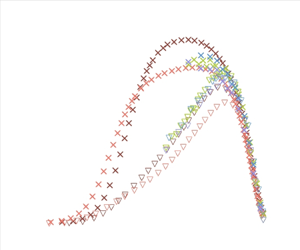No CrossRef data available.
Article contents
Consistent outer scaling and analysis of adverse pressure gradient turbulent boundary layers
Published online by Cambridge University Press: 04 March 2024
Abstract

Under adverse pressure gradient (APG) conditions, the outer regions of turbulent boundary layers (TBLs) are characterized by an increased velocity defect  $U_{e}-U$, an outwards shift of the peak value of the Reynolds shear stress
$U_{e}-U$, an outwards shift of the peak value of the Reynolds shear stress  $-\langle uv\rangle$ and an appearance of the outer peak value of the Reynolds normal stress
$-\langle uv\rangle$ and an appearance of the outer peak value of the Reynolds normal stress  $\langle uu\rangle$. Here
$\langle uu\rangle$. Here  $U_{e}$ is the TBL edge velocity. Scaling APG TBLs is challenging due to the non-equilibrium effects caused by changes in the APG. To address this, the response distance of TBLs to non-equilibrium conditions is utilized to extend the Zagarola–Smits scaling
$U_{e}$ is the TBL edge velocity. Scaling APG TBLs is challenging due to the non-equilibrium effects caused by changes in the APG. To address this, the response distance of TBLs to non-equilibrium conditions is utilized to extend the Zagarola–Smits scaling  $U_{zs} = U_{e}({\delta ^{*} }/{\delta })$ and ensure that the original properties of the Zagarola–Smits scaling are maintained as
$U_{zs} = U_{e}({\delta ^{*} }/{\delta })$ and ensure that the original properties of the Zagarola–Smits scaling are maintained as  $Re \to \infty$. Here
$Re \to \infty$. Here  $\delta ^{*}$ is the displacement thickness and
$\delta ^{*}$ is the displacement thickness and  $\delta$ is the boundary layer thickness. Based on the established correlation between
$\delta$ is the boundary layer thickness. Based on the established correlation between  $U_{e}-U$ and
$U_{e}-U$ and  $-\langle uv\rangle$, the scaling is extended to
$-\langle uv\rangle$, the scaling is extended to  $-\langle uv\rangle$. Furthermore, considering the coupling relationship between Reynolds stress components, the scaling is extended to encompass each Reynolds stress component. The proposed consistent scaling is verified using five non-equilibrium databases and five near-equilibrium databases, successfully collapsing the data of the TBL outer region. The pressure gradient parameter
$-\langle uv\rangle$. Furthermore, considering the coupling relationship between Reynolds stress components, the scaling is extended to encompass each Reynolds stress component. The proposed consistent scaling is verified using five non-equilibrium databases and five near-equilibrium databases, successfully collapsing the data of the TBL outer region. The pressure gradient parameter  $\beta =({\delta ^{*} }/{\rho u_{\tau }^{2} }) ({\mathrm {d} P_{e} }/{\mathrm {d}\kern0.7pt x})$ of these databases spans two orders of magnitude. Here
$\beta =({\delta ^{*} }/{\rho u_{\tau }^{2} }) ({\mathrm {d} P_{e} }/{\mathrm {d}\kern0.7pt x})$ of these databases spans two orders of magnitude. Here  $P_{e}$ is the boundary layer edge pressure,
$P_{e}$ is the boundary layer edge pressure,  $u_{\tau }$ is the friction velocity and
$u_{\tau }$ is the friction velocity and  $\rho$ is the density. Finally, the influence of the APG on the inner and outer regions of TBLs is analysed using the mean momentum balance equation. The analysis suggests that the shift of the
$\rho$ is the density. Finally, the influence of the APG on the inner and outer regions of TBLs is analysed using the mean momentum balance equation. The analysis suggests that the shift of the  $-\langle uv\rangle$ peak to the outer region under APG conditions is due to an insufficient inertia term near the inner region to balance the APG. It is observed that the APG promotes interaction between the inner and outer regions of TBLs, but the inner and outer regions still retain distinctive properties.
$-\langle uv\rangle$ peak to the outer region under APG conditions is due to an insufficient inertia term near the inner region to balance the APG. It is observed that the APG promotes interaction between the inner and outer regions of TBLs, but the inner and outer regions still retain distinctive properties.
JFM classification
- Type
- JFM Papers
- Information
- Copyright
- © The Author(s), 2024. Published by Cambridge University Press





